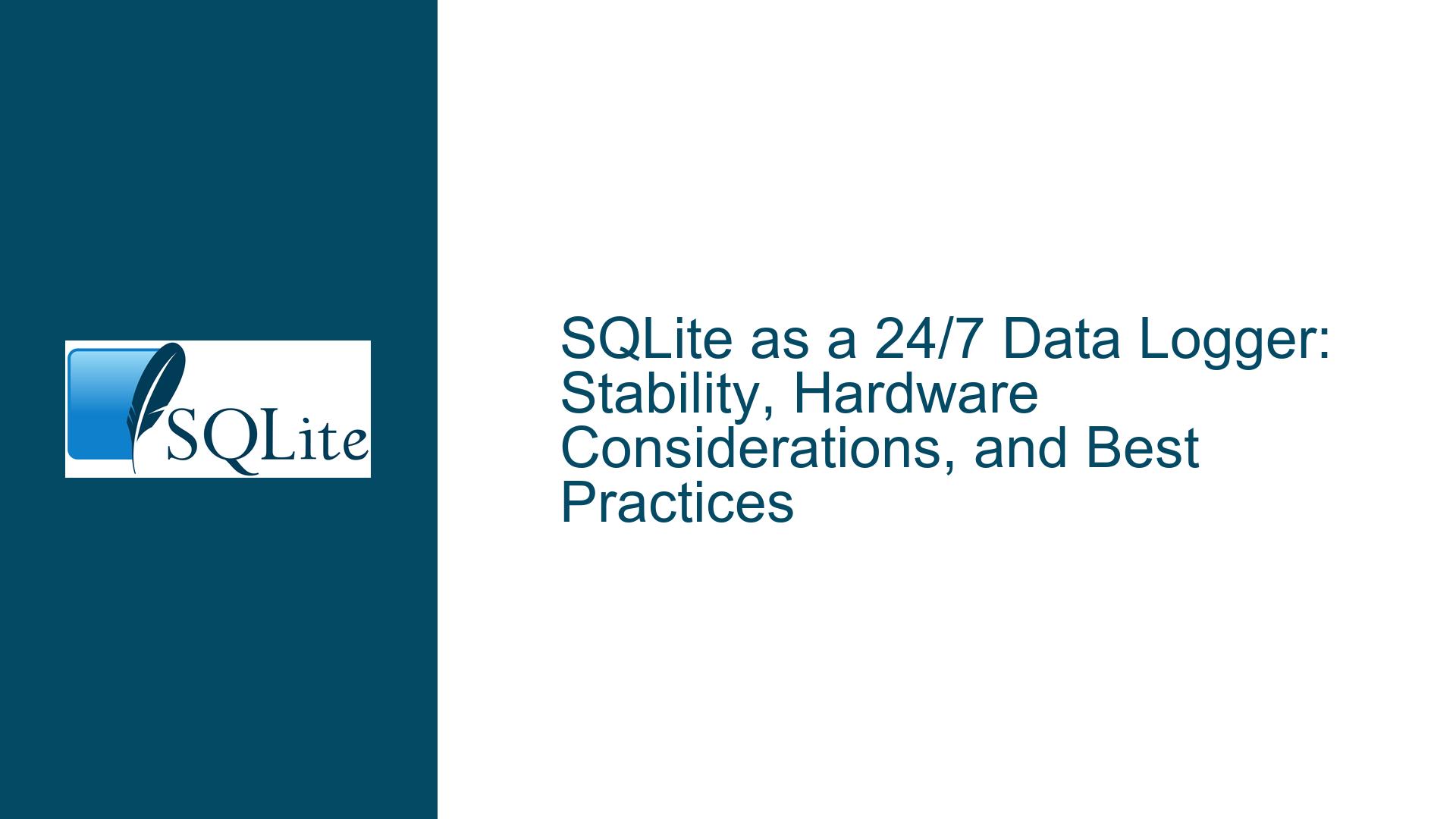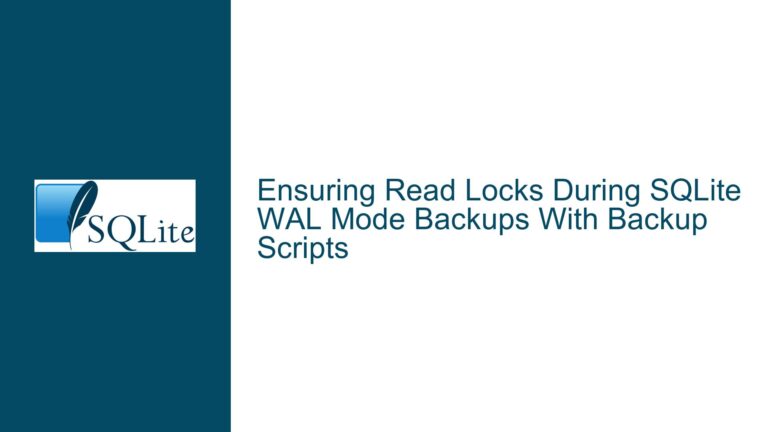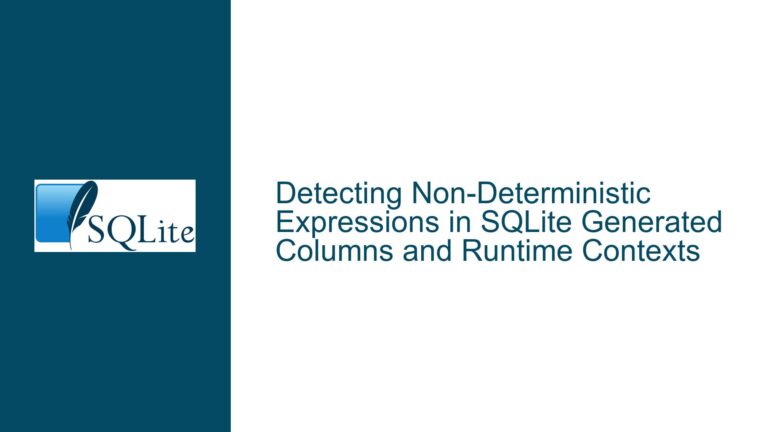SQLite as a 24/7 Data Logger: Stability, Hardware Considerations, and Best Practices
SQLite Stability and Performance in Continuous Data Logging Scenarios
SQLite is a robust, lightweight, and self-contained database engine that has been widely adopted for embedded systems, mobile applications, and data logging scenarios. Its stability and performance in continuous operation, such as 24/7 data logging, are often questioned due to the unique demands of such use cases. SQLite’s architecture is designed to handle concurrent read operations efficiently, but write-heavy workloads, especially in data logging, require careful consideration of hardware, configuration, and backup strategies.
One of the key strengths of SQLite is its ability to operate without a dedicated server process, making it ideal for resource-constrained environments like Raspberry Pi or other single-board computers. However, the stability of SQLite in these scenarios is not solely dependent on the database engine itself but also on the underlying hardware and operating system. For instance, running SQLite on a Raspberry Pi with an SD card as the primary storage medium can lead to hardware-related issues, such as I/O errors or wear-out, which are often mistaken for database instability.
SQLite’s transactional model ensures data integrity by writing changes to disk only when a transaction is committed. This design minimizes the risk of data corruption but also means that the durability of the database is closely tied to the reliability of the storage medium. In data logging applications, where writes are frequent and continuous, the choice of storage hardware becomes critical. High-endurance NVMe drives or SSDs are recommended over SD cards, which have limited write cycles and are prone to failure under heavy write loads.
Another aspect of SQLite’s stability is its ability to recover from unexpected shutdowns or crashes. SQLite uses a write-ahead log (WAL) mode, which allows it to recover quickly and efficiently from interruptions. However, this recovery mechanism relies on the integrity of the underlying file system and storage hardware. If the storage medium fails or becomes corrupted, SQLite’s recovery mechanisms may not be sufficient to restore the database.
In summary, SQLite’s stability and performance in 24/7 data logging scenarios are influenced by a combination of factors, including the database engine’s design, the hardware configuration, and the operating environment. Proper hardware selection, configuration tuning, and backup strategies are essential to ensure reliable and continuous operation.
Hardware Limitations and Storage Medium Considerations for SQLite Data Logging
The choice of hardware, particularly the storage medium, plays a critical role in the performance and longevity of SQLite-based data logging systems. SQLite’s durability and reliability are directly tied to the integrity of the storage medium, as all database transactions are written to disk. In data logging applications, where write operations are frequent and continuous, the storage medium must be capable of handling sustained write loads without degradation or failure.
SD cards, commonly used in single-board computers like the Raspberry Pi, are not ideal for SQLite data logging due to their limited write endurance. SD cards are designed for consumer-grade applications, such as cameras or smartphones, where write operations are relatively infrequent. In contrast, data logging involves continuous write operations, which can quickly exhaust the write cycles of an SD card, leading to I/O errors or complete failure. This issue is exacerbated by the fact that every SQLite commit requires a write operation, making the storage medium a potential bottleneck.
High-endurance storage solutions, such as NVMe drives or industrial-grade SSDs, are better suited for SQLite data logging. These drives are designed to handle high write loads and offer significantly higher write endurance compared to SD cards. For example, NVMe drives often come with official write endurance ratings, measured in terabytes written (TBW), which provide a clear indication of their expected lifespan under heavy write workloads. By selecting a storage medium with a high TBW rating, users can ensure that their SQLite database remains reliable and durable over extended periods.
In addition to write endurance, the performance of the storage medium also impacts SQLite’s efficiency. Faster storage devices reduce the latency of write operations, allowing SQLite to commit transactions more quickly. This is particularly important in high-frequency data logging scenarios, where delays in writing data can lead to backlogs or data loss. NVMe drives, with their high throughput and low latency, are well-suited for such applications.
Another consideration is the file system used on the storage medium. Some file systems, such as ext4 or F2FS, are better optimized for handling frequent write operations and can improve the performance and reliability of SQLite databases. Additionally, enabling features like journaling or write barriers can further enhance data integrity by ensuring that writes are properly synchronized with the storage medium.
In conclusion, the choice of storage medium is a critical factor in the success of SQLite-based data logging systems. High-endurance drives, such as NVMe or industrial-grade SSDs, are recommended for their ability to handle sustained write loads and provide reliable performance over time. Proper file system configuration and optimization can further enhance the durability and efficiency of SQLite databases in data logging applications.
Backup Strategies and Alternative Database Solutions for Data Logging
While SQLite is a versatile and reliable database engine for data logging, it is essential to implement robust backup strategies to safeguard against data loss or corruption. Data logging applications often involve critical or irreplaceable data, making backups a crucial component of the overall system design. Additionally, in some cases, alternative database solutions may offer advantages in terms of storage efficiency or specialized functionality.
Backup strategies for SQLite data logging systems should address both the configuration and the logged data. Configuration backups ensure that the system can be quickly restored in the event of a failure, while data backups protect against loss of logged information. SQLite provides several mechanisms for creating backups, including the .dump command, which generates a SQL script that can be used to recreate the database, and the VACUUM INTO command, which creates a compressed copy of the database.
For automated and continuous backups, tools like rsync or cron can be used to periodically copy the SQLite database file to a remote or secondary storage location. It is important to ensure that backups are performed during periods of low activity to minimize the impact on performance. Additionally, backups should be verified regularly to confirm their integrity and usability.
In some cases, alternative database solutions may be more suitable for specific data logging requirements. For example, time-series databases like InfluxDB are optimized for storing and querying time-stamped data, making them ideal for applications that involve high-frequency data logging. These databases often use specialized storage formats that reduce disk space usage and improve query performance for time-series data. However, they may lack the flexibility and general-purpose capabilities of SQLite.
SQLite’s support for standard SQL and its ability to handle a wide range of data types make it a versatile choice for general-purpose data logging. Its simplicity and ease of integration with existing systems are additional advantages. However, users should carefully evaluate their specific requirements, such as data volume, write frequency, and query complexity, to determine whether SQLite or an alternative database solution is the best fit.
In summary, backup strategies are essential for ensuring the reliability and durability of SQLite-based data logging systems. Automated and verified backups can protect against data loss or corruption, while alternative database solutions may offer advantages in specialized scenarios. By carefully considering these factors, users can design robust and efficient data logging systems that meet their specific needs.






